1.3 - A practice of analysis in the tonal harmonic discourse from Bach to Wagner ||
A) FORMULAS - 1. Definition of
a formula ::
2. Presentation of
the little catalogue of harmonic vocabulary ::
3. User's guide to
the little catalogue and various instructions ::
4. Examples
illustrating the little catalogue (motifs: 1, 2, 3, 4, 5, 6a, 6b, 7, 8, 9, 10, 11, 12, 13, 14, 15, 16, 17, 18, 19, 20, motifs in combination)
B) SEQUENCES - 1. Definition of a
harmonic sequence :: 2. Classifying
sequences :: 3. Melodic
formulations: characteristic motifs :: 4. The tonal
nature of the harmonic sequence :: 5.The tripartite
structure of the harmonic sequence :: 6. A
modulating sequence or not? :: 7. Diversification
of harmonic content :: 8. The harmonic
sequence as a place of subversion :: 9. Conclusion
3. MELODIC FORMULATIONS: CHARACTERISTIC MOTIFS

Classify
in order to identify, we said. Well, what attracts the ear or
catches the eye in a harmonic sequence is primarily the movement of the
outer voices. The melodic formulation of these twelve types of
sequences can vary infinitely, particularly in function of the
harmonic content. Not just in any old way, however. Variation is
realized and elaborated based on characteristic motifs that themselves
arise from typical voice leading for passing from one chord to
the next. These motifs lend themselves to melodic invention by
providing a sort
of skeleton or frame. To illustrate this, we will examine the four
types
of sequences which exhibit the highest rate of recurrence throughout the
discourse from Bach-Wagner, namely types 1, 4, 7, and 8 sequences.
a. Characteristic motifs of the type 1 sequence
Here
is the simplest formulation (expressed in four voices) of this
sequence featuring the melodic motif which, combined with the bass,
will serve to identify it. This motif is most often presented in the upper
voice but it may appear in another voice:
Figure 22
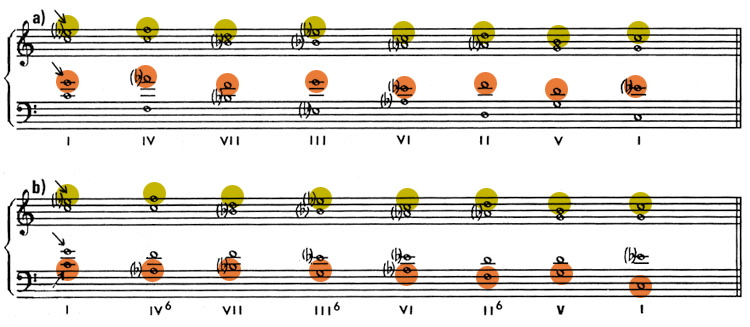
-
This first melodic motif essentially articulates a broken line, observable in the
soprano and tenor in figure 22 a) as well as in the bass in figure
22 b)
Example 395 : R. Schumann : Albumblätter, op. 124, no 4, Waltz (mm 21-28)
Type 1 sequence

Example 396 : W.A. Mozart : Piano sonata, K. 545, I (mm 18-21)
Type 1 sequence
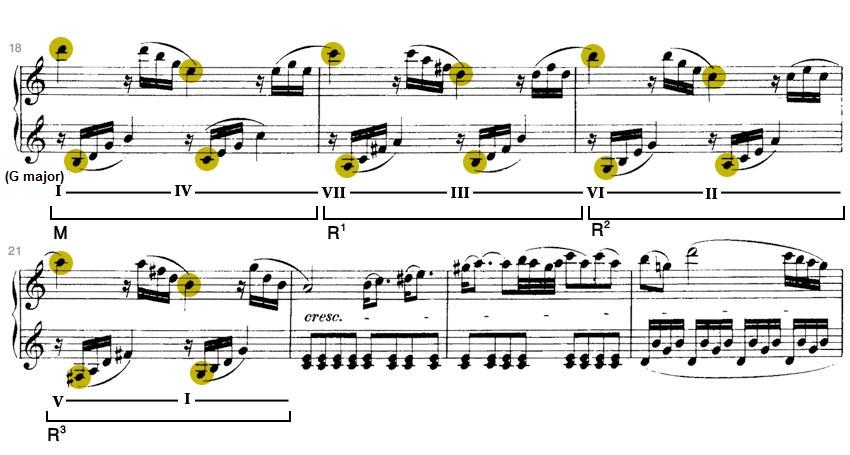
- The intervention of secondary dominants causes a second melodic motif to appear, namely a descending chromatic scale:
Figure 23

Example 397 : F. Sor : Etude for guitar, op. 31, no 20 (mm 6-9)
Type 1 sequence
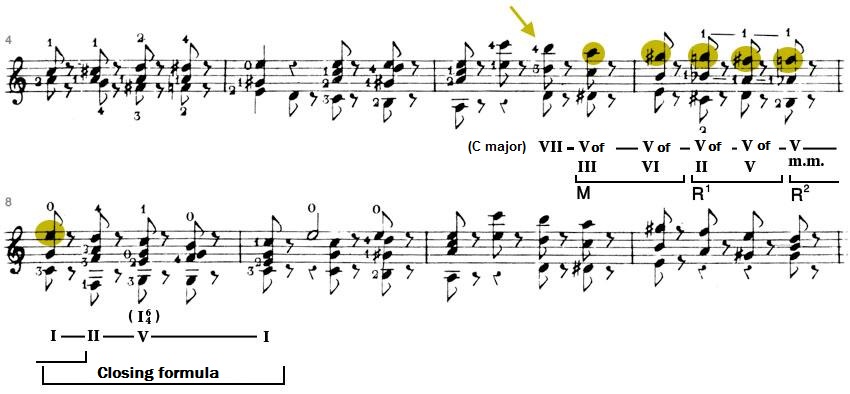
-
A third motif, born of the intervention of seventh chords, articulates a
descending diatonic scale progressing every second chord:
Figure 24

Example 398 : J.S. Bach : Brandenburg Concerto no 3, BWV 1048, II (mm 7-9)
Type 1 sequence
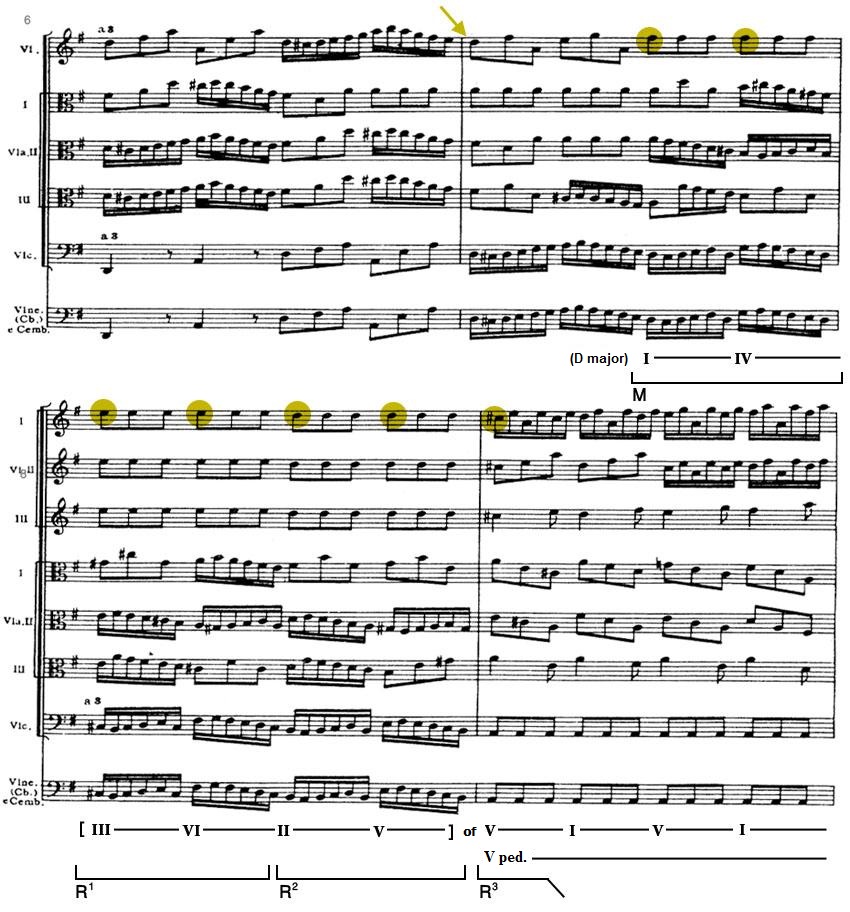
The following text juxtaposes the second and third motifs in the upper voice:
Example 399 : J. Haydn : Piano sonata, Hob. XVI:20, III (mm 107-119)
Type 1 sequence
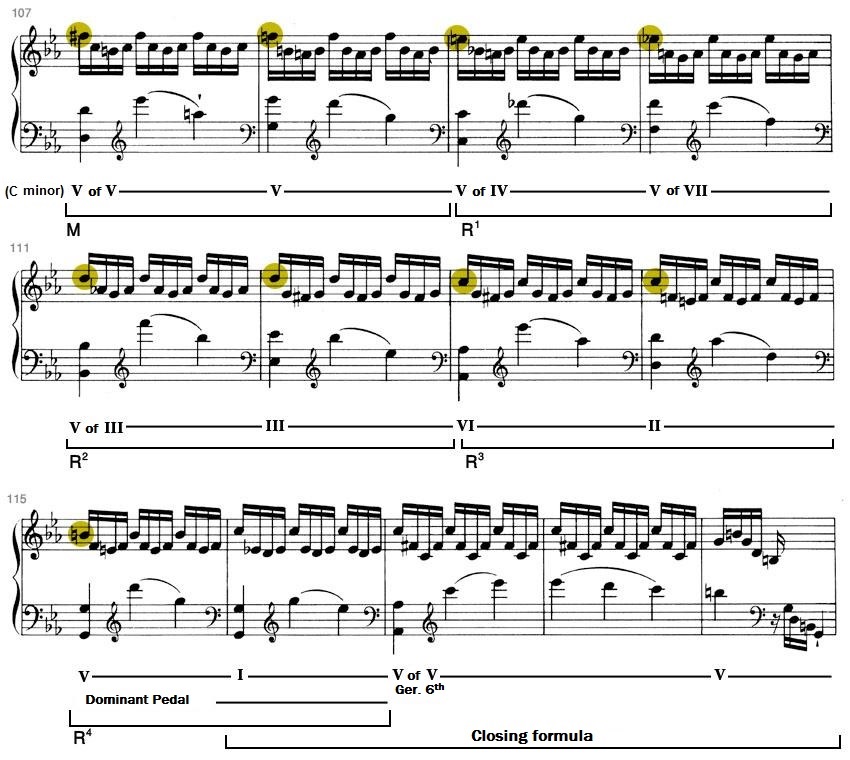
Example 400 : J.S. Bach : Concerto in D minor for organ, after A. Vivaldi or W.F. Bach, BWV 596, III, Allegro moderato (mm 7-14)
Type 1 sequence: the first occurrence of the
sequence articulates the third motif whereas the second occurence articulates the second and third motifs simultaneously:

b. Characteristic motifs of the type 7 sequence
The
formulation of this sequence - an ascending counterpart to the type 1
sequence - also grafts itself onto three principal motifs:
- an ascending diatonic scale progressing every two chords:
Figure 25

Example 401 : J.S. Bach : Christmas Oratorio, BWV 248, chorale from the end of section III, final phrase
Type 7 sequence
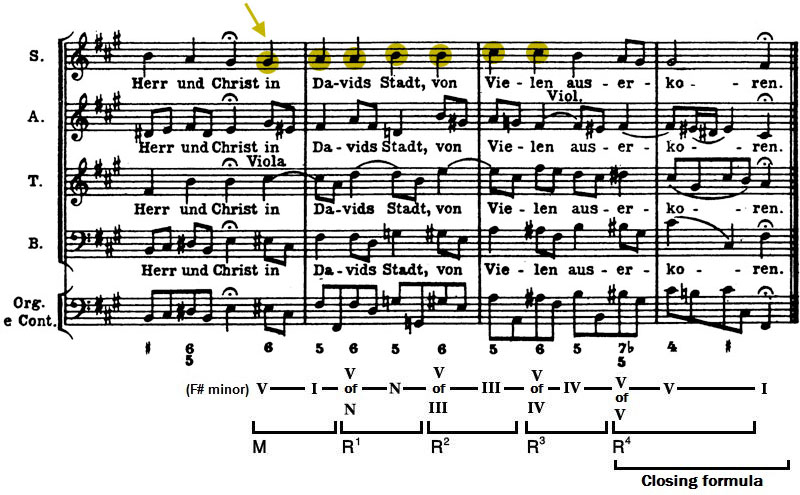
Example 402 : L.V. Beethoven : Piano sonata, op. 28, III, Scherzo (mm 33-48)
Type 7 sequence

-
an ascending chromatic scale due to the use of secondary dominants
(as we can observe in the treatment of the bass in the previous examples 401 and 402):
Figure 26

Example 403 : F. Liszt : Transcendental Etude no 1 (mm 1-3)
Type 7 sequence
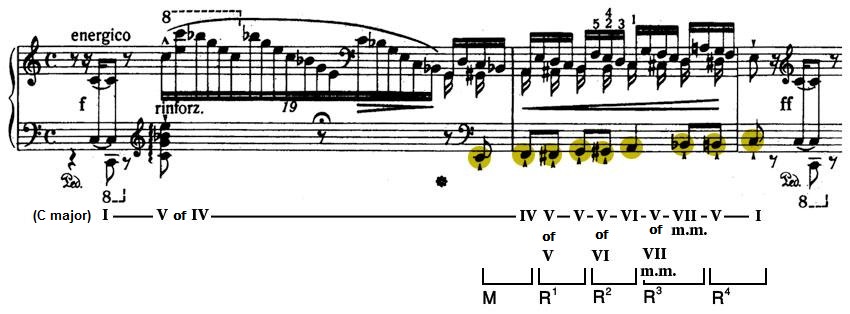
Example 404 : C.P.E. Bach : Württemberg Sonata no 2, III, Allegro (mm 52-64)
Type 7 sequence

-
a gesture of a descending third which progresses by the interval of
a second and results from systematic use of contrary motion
between the upper voices and the bass
(as observed in the upper voice in the preceding example):
Figure 27

Example 405 : J.S. Bach : Italian Concerto, BWV 971, I (mm 42-46)
Type 7 sequence
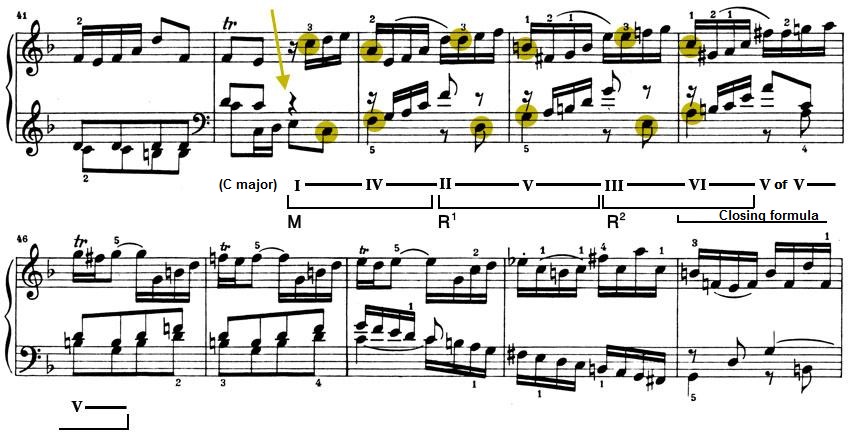
Example 406 : A. Corelli : Sonata for trombone, op. 5, no 9, Gigue (mm 5-9)
Type 7 sequence
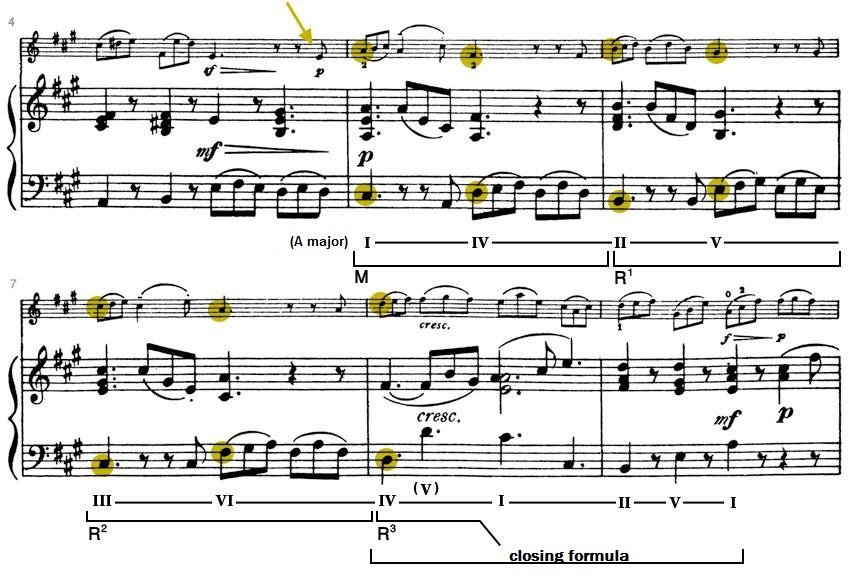
Example 407 : W.A. Mozart : Sonata for two pianos, K. 448, III (mm 85-92)
Type 7 sequence
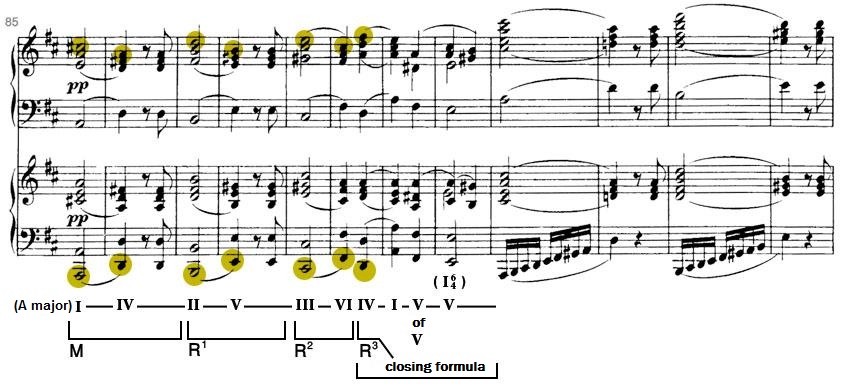
Here we observe, in a passage over a dominant pedal, a type 7 sequence which is immediately answered in mirror image by a type 1 sequence that also takes on the role of a closing formula:
Example 408 : J.S. Bach : Brandenburg Concerto no 5, BWV 1050, I (mm 190-195)
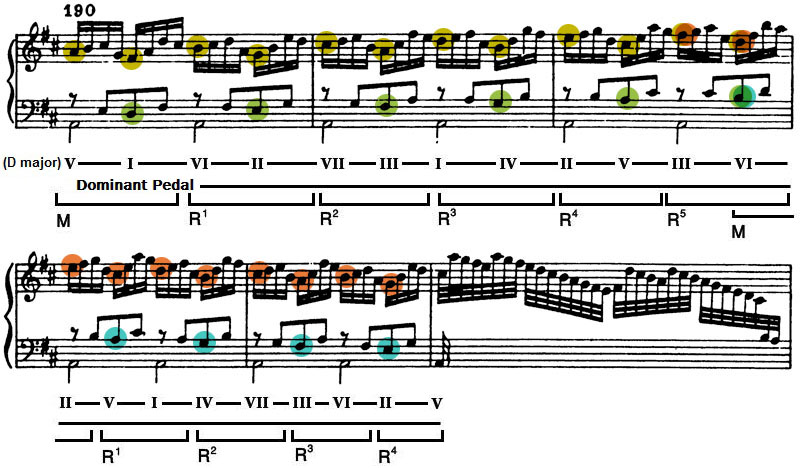
c. Characteristic motifs of the type 4 sequence
The realization of the type 4 sequence presents two contrasting motifs.
- The first motif forms a descending diatonic scale progressing with each chord:
Figure 28

Example 409 : J. Pachelbel : Canon in D (mm 1-11)
Type 4 sequence
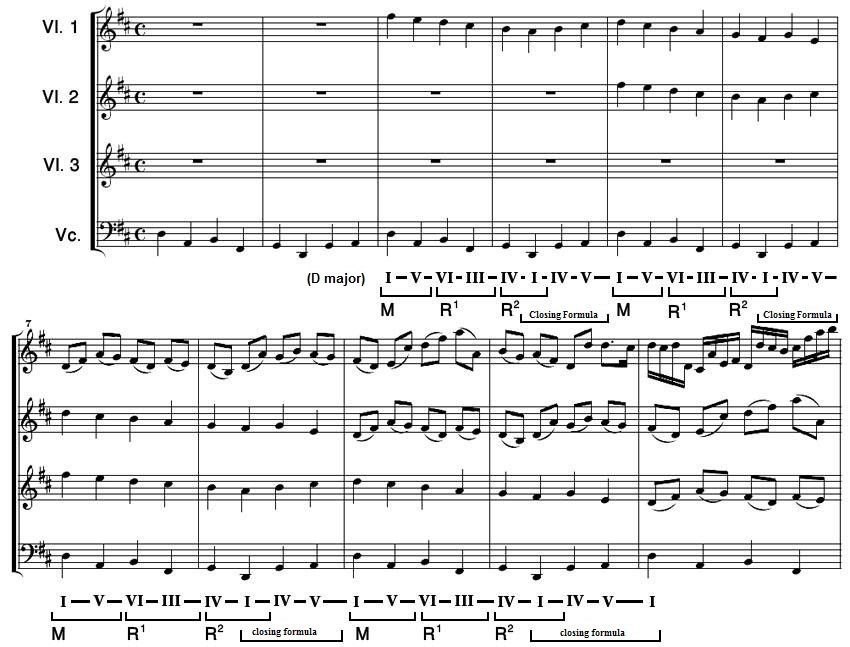
Example 410 : J.P. Rameau : The Temple of Glory, Gavotte, Trio (mm 1-4)
Type 4 sequence

-
The second motif, featuring alternating root position and
first inversion chords, results in a rising third gesture, progressing
by thirds. This particularly spacious outline lends itself to a multitude
of possible realizations. In this case, the bass articulates a descending diatonic
scale:
Figure 29

Example 411 : L.V. Beethoven : Piano sonata, op. 25, no 79, III (mm 1-4)
Type 4 sequence

Example 412 : L.V. Beethoven : Piano sonata, op. 109, I (mm 1-4)
Type 4 sequence

Example 413 : F. Chopin : Etude, op. 25, no 9 (mm 1-4)
Type 4 sequence

d. Characteristic motif of the type 8 sequence
For
the type 8 sequence we will retain only the most common motif, namely
an ascending diatonic scale progressing with each chord:
Figure 30

Example 414 : W.A. Mozart : Piano concerto no 22, K. 482, I, Allegro (mm 216-222)
Type 8 sequence
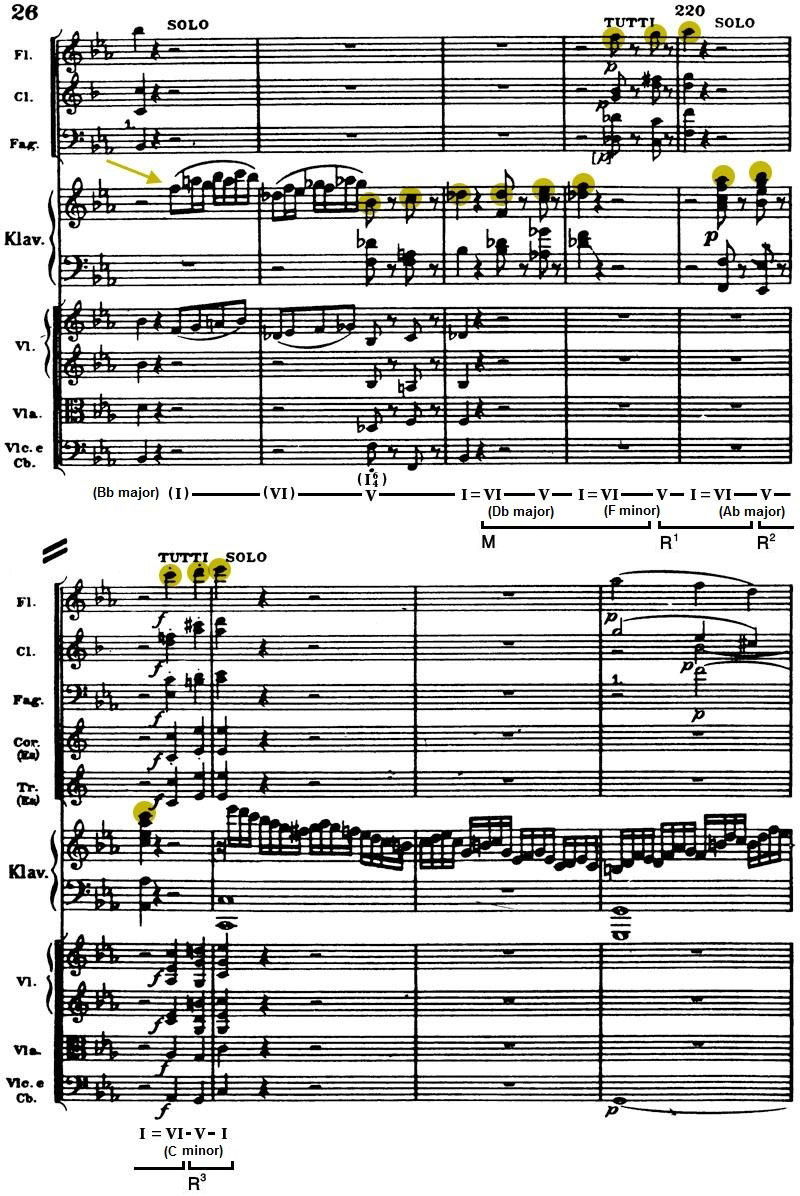
Example 415 : L.V. Beethoven : Piano sonata no 30, op. 109, I, Vivace ma non troppo (mm 25-33)
Type 8 sequence
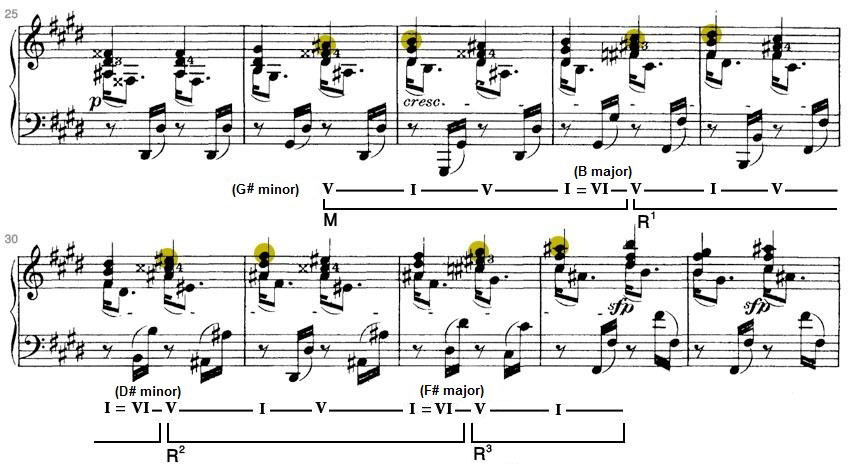
Example 416 : C.M.v. Weber : Der Freischütz, Overture, Molto vivace (mm 73-77)
Type 8 sequence

4. THE TONAL NATURE OF THE HARMONIC SEQUENCE |
